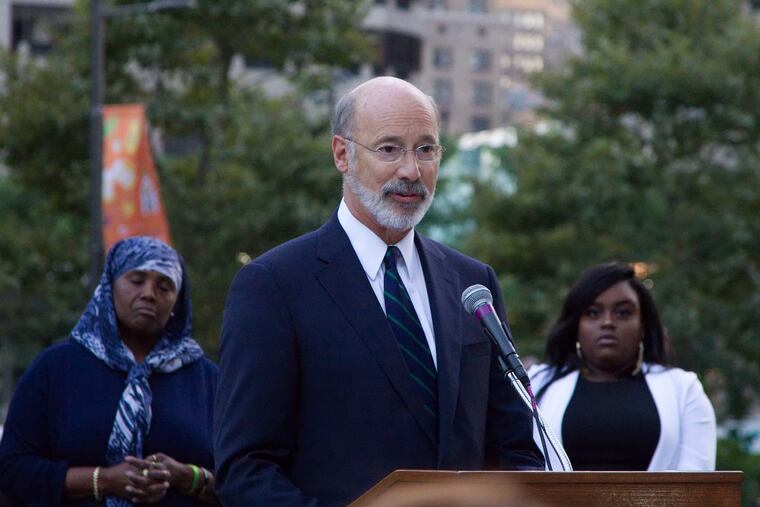New Pa. poll finds positive signs for Gov. Wolf, Democratic U.S. House candidates
Signs look good for Pennsylvania Gov. Wolf, a Democrat, as he seeks reelection, with nearly half saying the state is heading in the right direction and 50 percent holding a favorable view of the governor personally, according to a new Franklin and Marshall College poll.

Nearly half of Pennsylvania registered voters, 46 percent, believe the state is "headed in the right direction," according to a new Franklin and Marshall College poll released Thursday — the first time since 2009 that more respondents chose that option than said the state was on the wrong track.
"That's primarily driven by improvements in the economy. Compared to even a few years ago, a lot more people are working," said Terry Madonna, poll director and public-affairs professor at the Lancaster college. The recession of 2008-09 was deeper and the recovery was slower in Pennsylvania than in some other parts of the nation.
Forty percent of respondents in the new poll agreed with the proposition that the state was on the wrong track.
The survey, conducted for the Inquirer and Daily News and other news outlets across the state, found a high level of interest in this year's midterm elections, with 48 percent of voters saying they were very interested and paying close attention to the campaigns. In addition, 60 percent of Democrats, compared to 41 percent of Republicans, placed themselves in the "very interested" category — often used by pollsters as a measure of relative partisan enthusiasm.
More registered voters said they expected to vote for the Democratic candidate for U.S. House in their district than picked the Republican, 42 percent to 35 percent, a 7-percentage-point advantage. By comparison, Democrats were favored by an average of 6.8 percentage points on the so-called generic ballot test in the Real Clear Politics compendium of polls conducted between March 10 and 27.
"What we're seeing here is more evidence of a Democratic wave," Madonna said, noting that there is plenty of time for the out party's advantage to shrink. Given historical trends of the party that does not hold the White House picking up House seats in a president's first-term midterm elections, "The only thing we're going to be debating is the size of the wave," Madonna said.
Democratic Gov. Wolf, seeking his second term, sits in a strong position a little more than seven months from Election Day, the poll found. Wolf had a personal favorability rating of 50 percent when combining voters who had "strongly" or "somewhat" favorable views of the governor. He had not reached that level of approval since taking office in January 2015.
Wolf probably benefits from the general sense of Democratic momentum and increased optimism about the economy in Pennsylvania. He has contended with strong GOP opposition in the legislature, but has a calm personality and "no definable negatives," Madonna said.
Tested head-to-head with the three Republicans vying to take him on, Wolf held substantial leads against State Sen. Scott Wagner of York County, Allegheny County businessman Paul Mango, and Allegheny County lawyer Laura Ellsworth. However, large percentages of registered voters said they were undecided in these hypothetical match-ups.
In other findings, the poll showed broad support for increased restrictions on firearms following the Parkland, Fla., school shootings and the anti-gun-violence youth protests – 86 percent of registered voters favored expanded background checks for gun purchases, 61 percent backed a ban on assault-style weapons, and 59 percent said the minimum age to purchase a gun should be raised to 21.
Results of the F&M poll are based on live telephone interviews with 423 Pennsylvania registered voters between March 19 and 26. The error margin for the survey is plus or minus 6.8 percentage points.